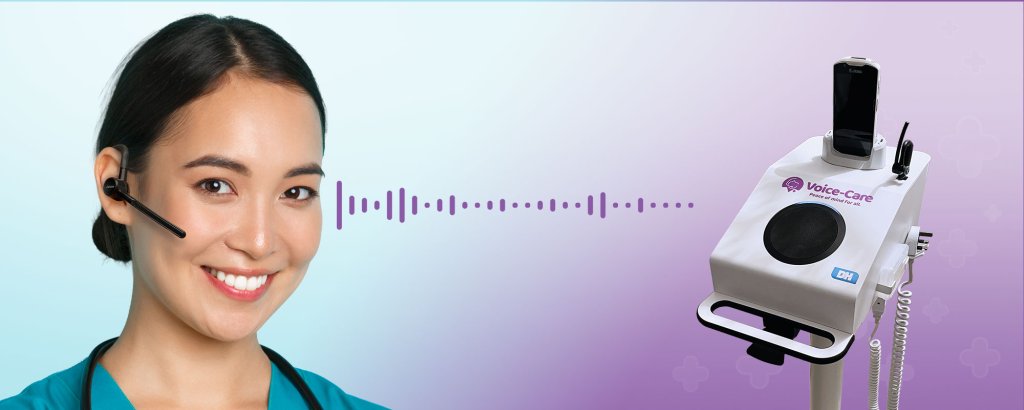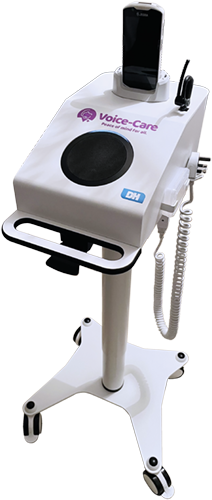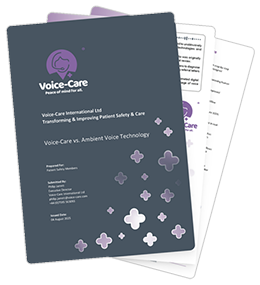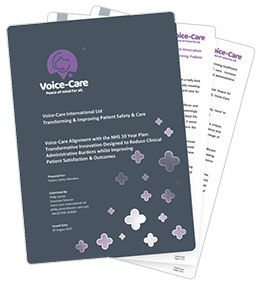Voice-Care vs. Ambient Voice Technology

What is Ambient Voice Technology (AVT)?
Ambient Scribing Products, which include Ambient Voice Technologies (AVTs), are designed to unobtrusively record a conversation between a patient and a caregiver, using advanced speech technologies and recognition to automatically convert a dialogue into text and other outputs.
After passing through a cloud-based server, the text file is sent back to the device the audio was originally recorded on, so that the relevant patient record is immediately updated for subsequent clinical review.
AVTs are designed to support clinical or patient documentation and workflows, assisting clinicians to diagnose the patient’s condition and recommend treatments, as well as scheduling appointments, drafting referral letters and ordering tests.
Earlier versions of ambient scribing products, such as traditional speech recognition and automated digital dictation tools, have been used within health and care settings for some time, however the usage of voice technology and its powerful capabilities throughout the healthcare sector is rapidly evolving.

What is Voice-Care?
Whilst AVTs are an extremely useful tool, Voice-Care does not fall into any AVT category.
Voice-Care is a revolutionary healthcare solution designed to enhance patient safety and care. Providing healthcare professionals with the tools they need to optimise processes and improve patient outcomes, it empowers clinicians to work totally hands and eyes free whilst enabling the simplification of the recording of patient observations and workflows via the use of voice, directly from the operating theatre or point of care.

How Does Voice-Care Differ from Ambient Voice Technology?
Voice-Care is a voice-guided and voice-directed system that provides users with step-by-step guidance and processes for them to follow, using best-practice, clinically-designed workflows for a range of applications including surgical workflows, radiology and bedside care.
It guides clinicians through a pre-defined, pre-planned sequence of steps within any standardised workflow, enforcing consistency of data entry and restricting users from proceeding within a particular workflow unless the system receives the correct response to the question in flight.
In simple terms, via the use of specialist voice technology, the Voice-Care platform asks a specific question and only upon receipt of the correct verbal response, will it then proceed to the next question in the sequence, ignoring and mitigating any other irrelevant responses, conversations or background noise.
It is however important to note that Voice-Care can accommodate AI tools such as AVTs should any workflow require this; a feature that is made possible thanks to our partnerships with Microsoft and Nuance (alongside its various platforms including DAX: ‘Dragon Ambient eXperience’).
In summary, Voice-Care directs the order of actions, collecting and storing data in a consistent format, bringing standardisation to differing workflow interpretations and ensuring 100% clinical accuracy and compliance.

Ambient Voice Technology (AVT) records conversations between patients & clinicians/caregivers
Voice-Care provides clinicians/caregivers with step-by-step voice guidance through clinically-designed workflows
AVT relies upon the free speech of the patient & the clinician/caregiver
Voice-Care directs order of actions & results, removing human factor issues
AVT does not enable procedural monitoring
Voice-Care provides procedural monitoring for improved patient safety & care
AVT does not promote the standardisation of procedures or the recording of the resultant data
Voice-Care brings standardisation to differing workflow interpretations & the recording of data
AVT supports clinical or patient documentation & workflows
Voice-Care voice-enables specific workflows to ensure 100% accuracy & compliance
AVT uploads conversation data to the patient record
Voice-Care instantly uploads data to the patient record in real-time
Earlier versions of AVTs (traditional speech recognition/digital dictation) have been in use in the healthcare sector for some time
Voice-Care is built upon an industrial voice interface that has been utilised, tried & tested for over 25 years
AVT has one singular use: to record conversations between the patient & the caregiver
Voice-Care can be used with any clinically-designed workflows within a range of applications including bedside care, radiology & surgical workflows
With AVT, conversations are recorded on a single, consumer-grade device
Voice-Care can record discreet workflow transactions via a headset microphone/earpiece or can broadcast a workflow to a large group of personnel via a speaker & inbuilt microphone (Voice-Care is a partner of Jabra, the world’s leading audio device hardware manufacturer)
AVT struggles to capture relevant information when used within noisy or busy environments
Voice-Care filters out irrelevant conversations or comments; it only seeks a specific response to a workflow step
AVT may struggle to understand accents or dialects, particularly within loud environments
Voice-Care's voice interface has machine learning capabilities embedded as standard; helping to understand accents, dialects & 40+ languages
AVT records only free speech, so errors are likely to occur & there is no compliance monitoring
Voice-Care delivers 100% accuracy & compliance, first time; every time
AVT does not automatically record a conversation start or end time
Voice-Care records sign in, procedure start & end time in real time
AVT does not have an option to provide evidentiary documentations such as photographs or videos
Voice-Care has the option to provide real-time evidentiary documentation such as photographs or videos
AVT saves on time & manpower
Voice-Care enables up to 30% efficiency gains

